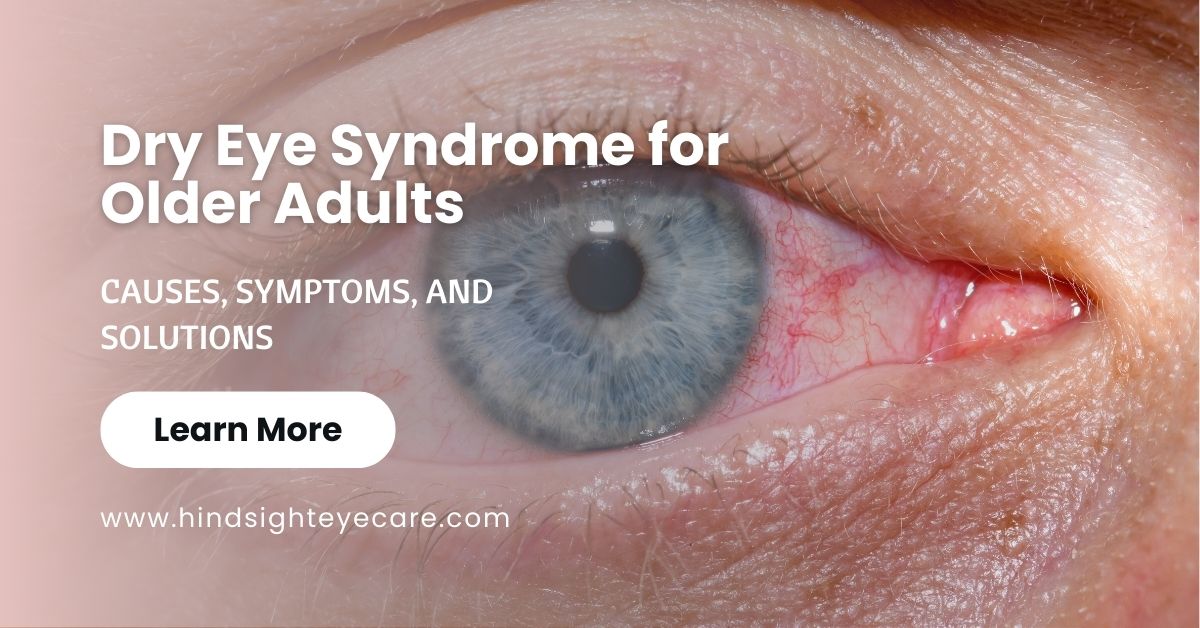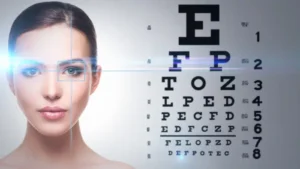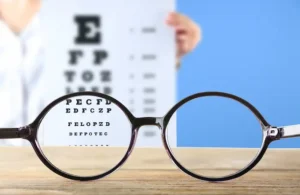Dry Eye Syndrome
One common issue that many adults over 40 face is dry eye syndrome. At Hindsight Eye Care in The Villages, Florida, we understand how this condition can impact your daily life and overall eye health.
Dry eye syndrome, also known as keratoconjunctivitis sicca, is a condition where your eyes don’t produce enough tears or the tears evaporate too quickly. This can lead to discomfort, vision problems, and even damage to the eye’s surface if left untreated.
In this comprehensive guide, we’ll explore the causes, symptoms, and solutions for dry eye syndrome, with a special focus on how it affects older adults.
Causes of Dry Eye Syndrome in Older Adults
As we age, several factors contribute to the increased likelihood of developing dry eye syndrome:
- Decreased Tear Production: With age, our tear glands may produce fewer tears.
- Hormonal Changes: Especially in post-menopausal women, hormonal imbalances can affect tear production.
- Medications: Many common medications for conditions like high blood pressure or arthritis can cause dry eyes as a side effect.
- Environmental Factors: Florida’s sunny climate and air conditioning can contribute to tear evaporation.
- Screen Time: Increased use of digital devices can lead to reduced blinking and eye strain.
- Medical Conditions: Conditions like diabetes, rheumatoid arthritis, and thyroid disorders can increase the risk of dry eyes.
Symptoms of Dry Eye Syndrome
Recognizing the symptoms of dry eye syndrome is the first step towards finding relief. Common symptoms include:
- A stinging or burning sensation in the eyes
- Feeling like there’s something gritty in your eyes
- Redness and irritation
- Blurred vision, especially when reading or using a computer
- Difficulty wearing contact lenses
- Excessive tearing (paradoxically, as the eyes try to compensate)
- Sensitivity to light
If you’re experiencing any of these symptoms, it’s important to schedule an eye exam with an optometrist at Hindsight Eye Care for a proper diagnosis.
Diagnosis of Dry Eye Syndrome
During your eye exam, our experienced optometrists will use several tests to diagnose dry eye syndrome:
- Comprehensive Eye Exam: This includes a detailed discussion of your symptoms and medical history.
- Tear Film Evaluation: We’ll assess the quantity and quality of your tears.
- Schirmer’s Test: This measures your tear production.
- Tear Osmolarity Test: This checks the composition of your tears.
- Corneal Staining: We may use special dyes to reveal any damage to your eye’s surface.
These tests help us determine the severity of your condition and guide our treatment recommendations.
Treatment Options for Dry Eye Syndrome
At Hindsight Eye Care, we offer a range of treatments for dry eye syndrome, tailored to each patient’s specific needs:
- Artificial Tears: Over-the-counter eye drops can provide temporary relief.
- Prescription Medications: Eye drops like Restasis or Xiidra can help increase tear production.
- Punctal Plugs: These tiny devices can be inserted to block tear drainage, keeping your eyes moist.
- Lifestyle Changes: Simple adjustments like using a humidifier or taking regular screen breaks can help.
- Nutritional Supplements: Omega-3 fatty acids may improve tear quality.
- Advanced Treatments: For severe cases, we may recommend treatments like intense pulsed light therapy or autologous serum tears.
Preventing Dry Eye Syndrome
Prevention is always better than cure. Here are some tips to help prevent or manage dry eye syndrome:
- Stay hydrated by drinking plenty of water
- Use protective eyewear when outdoors
- Take regular breaks when using digital devices (follow the 20-20-20 rule)
- Maintain a healthy diet rich in omega-3 fatty acids
- Avoid smoking and limit alcohol consumption
- Use a humidifier in your home, especially in air-conditioned spaces
At Hindsight Eye Care, our comprehensive eye exams not only check for dry eye syndrome but also screen for other age-related eye conditions like glaucoma, cataracts, and macular degeneration.
Living with Dry Eye Syndrome in The Villages
The Villages offers a vibrant lifestyle for active adults, but the Florida sun and outdoor activities can exacerbate dry eye symptoms. Here are some tips for managing dry eyes while enjoying life in our community:
- Wear wraparound sunglasses when golfing or participating in other outdoor activities
- Use preservative-free artificial tears before and after swimming
- Consider using a desktop humidifier if you spend a lot of time indoors with air conditioning
- Stay hydrated, especially when engaging in physical activities
Advanced Technologies for Dry Eye Treatment
At Hindsight Eye Care, we’re committed to offering the latest technologies for diagnosing and treating dry eye syndrome:
- LipiFlow: This FDA-approved device uses heat and pressure to unclog blocked meibomian glands, improving tear quality.
- TearLab Osmolarity System: This advanced diagnostic tool measures the saltiness of your tears, helping us tailor your treatment plan.
- Intense Pulsed Light (IPL) Therapy: Originally used in dermatology, IPL has shown promising results in treating dry eye syndrome by improving meibomian gland function.
The Role of Eyewear in Managing Dry Eyes
For our patients who wear eyeglasses or contact lenses, managing dry eye syndrome requires special consideration:
Eyeglasses:
- Consider lenses with anti-reflective coatings to reduce glare and eye strain
- Explore photochromic lenses that darken in sunlight, providing extra protection outdoors
Contact Lenses:
- Discuss switching to daily disposable lenses, which can be more comfortable for dry eyes
- Explore specialty contact lenses designed for dry eye sufferers
During your eye exam at Hindsight Eye Care, we can help you choose the best eyewear options to complement your dry eye treatment plan.
The Impact of Dry Eyes on Quality of Life
Dry eye syndrome can significantly impact your daily activities and overall quality of life. Many of our patients in The Villages report:
- Difficulty reading or using computers for extended periods
- Discomfort when watching television or movies
- Challenges with night driving due to glare sensitivity
- Reduced enjoyment of outdoor activities
By addressing your dry eye symptoms, we aim to help you fully engage in the active lifestyle that The Villages is known for.
| Aspect | Details |
| Definition of Dry Eye Syndrome | A condition where eyes don’t produce enough tears or tears evaporate too quickly |
| Common Causes in Older Adults | Decreased tear production due to aging – Hormonal changes (especially in post-menopausal women) – Side effects of medications – Environmental factors (Florida’s climate, air conditioning) – Increased screen time – Medical conditions (e.g., diabetes, rheumatoid arthritis) |
| Symptoms | – Stinging or burning sensation in eyes – Feeling of grittiness – Redness and irritation – Blurred vision – Difficulty wearing contact lenses – Excessive tearing – Light sensitivity |
| Diagnosis Methods | – Comprehensive eye exam – Tear film evaluation – Schirmer’s test – Tear osmolarity test – Corneal staining |
| Treatment Options | – Artificial tears – Prescription medications (e.g., Restasis, Xiidra) – Punctal plugs- Lifestyle changes – Nutritional supplements (Omega-3 fatty acids) – Advanced treatments (e.g., LipiFlow, IPL therapy) |
| Prevention Tips | – Stay hydrated – Use protective eyewear outdoors – Take regular breaks from screen use (20-20-20 rule) – Maintain a healthy diet – Avoid smoking and limit alcohol – Use a humidifier at home |
| Impact on Daily Life in The Villages | – Difficulty with reading and computer use – Discomfort during outdoor activities – Challenges with night driving – Reduced enjoyment of sports and hobbies |
| Advanced Technologies at Hindsight Eye Care | – LipiFlow for unclogging meibomian glands -TearLab Osmolarity System for precise diagnosis – Intense Pulsed Light (IPL) Therapy |
Dry Eyes and Other Eye Conditions
It’s important to note that dry eye syndrome can coexist with or even mask other eye conditions. This is why comprehensive eye exams are crucial. Some conditions that may be related to or confused with dry eyes include:
- Blepharitis (inflammation of the eyelids)
- Meibomian gland dysfunction
- Allergic conjunctivitis
- Ocular rosacea
Our experienced optometrists at Hindsight Eye Care are trained to differentiate between these conditions and provide appropriate treatment.
The Final Wording!
Dry eye syndrome, while common among older adults, doesn’t have to diminish your quality of life. With proper diagnosis, treatment, and management, you can find relief from dry eye symptoms and continue to enjoy all that The Villages has to offer.
At Hindsight Eye Care, we’re committed to providing personalized, comprehensive eye care to our community. Whether you’re experiencing symptoms of dry eyes or it’s simply time for your annual eye exam, we invite you to schedule an appointment with one of our experienced optometrists.
Don’t let dry eyes hold you back from enjoying life to the fullest. Contact Hindsight Eye Care today to take the first step towards healthier, more comfortable eyes. Your vision is our priority, and we’re here to ensure you see clearly and comfortably for years to come.




